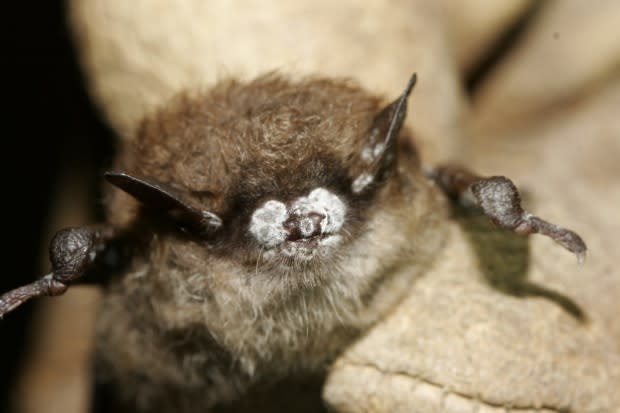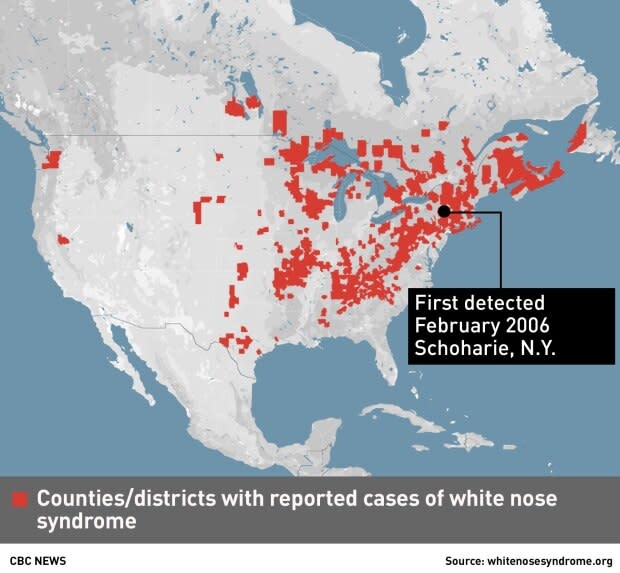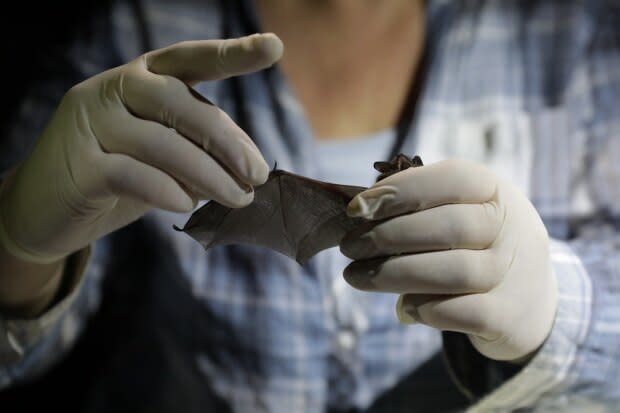Fighting a bat killer: B.C. scientists testing new way to protect against deadly fungus
For Leah Rensel, there's nothing better than dipping your hands into a plastic trap full of angry bats.
The University of British Columbia Okanagan grad student has a smile on her face as she grabs the tiny mammals that have been caught in a special device that waylays them as they exit the plywood bat box they call home.
She holds one in her gloved hands, trying to identify the species as it nips at her fingertips.
"Probably a little brown, by the way he's biting me," she says as she balances on a ladder at dusk in a park in Port Coquitlam, a Vancouver suburb.
Rensel is part of a team working late into the night to capture the critters and treat their nesting boxes in an experimental attempt to halt the spread of a bat-killing fungus.
White nose syndrome has ripped through North American bat populations, killing millions.
On this night, the bat, unhappy at being caught, opens its mouth and struggles to escape. Instead of vampire-like fangs, tiny teeth line its mouth.

"A juvenile, the young of the year. If he bites me, he can't break the skin," Rensel says before stuffing him into a bag and handing it off to colleagues on the ground.
Overseeing the operation is biologist Cori Lausen, a bat specialist with the Wildlife Conservation Society Canada.
"White nose syndrome is touted as the most catastrophic wildlife disease to hit North America in recorded history," she says.
It's caused by a fungus that's decimating bat populations. It slowly weakens the animals until they die of starvation. It was first detected in the eastern United States in 2006 and has wiped out entire populations there.
The syndrome has spread to seven Canadian provinces. It was found first in Ontario and Quebec, then Nova Scotia and New Brunswick, Prince Edward Island, Newfoundland and Labrador. Most recently it's been found in Manitoba and to the south of British Columbia in Washington State.

Lausen says bats play a crucial role in the ecosystem, devouring insects and spreading fertilizer in the form of poop, or bat guano.
"If we don't have bats, if our natural predator is gone from the night sky, pesticide use will increase, as has already happened in the east."
In some caves where the winged mammals hibernate over winter, mortality has exceeded 90 per cent.

The goal is to prevent it from taking hold in B.C. by using helpful bacteria.
Researchers at Thompson Rivers and McMaster universities worked with the Wildlife Conservation Society Canada to isolate and test probiotic bacteria found naturally in soil in B.C. The bacteria biologically counter the fungus that causes white nose syndrome.
Hopes for probiotic cocktail
Nicolas Fontaine, a master's student at Thompson Rivers University, helped develop and test the probiotic cocktail on captive bats to ensure it is safe for use in the field.
"I have a lot of hope this is going to work," he said as he put on protective clothing and climbed a ladder to apply the spray.
This night's test is the first time he's used it in the field, dousing the bat boxes where the bacteria should spread and replicate on the skin of the bats.

In lab tests, it stopped the fungus, and the team believes it will work in the wild, spread by the bats as they migrate and mate.
"They go away to hibernation, they still have this probiotic bacteria, they can fight off the white nose syndrome fungus, and therefore more of them come back after hibernation."
Up to 99.9% lethal
Canada's National White Nose Syndrome Scientific Program is tackling the problem across the country with help from governments, universities and wildlife agencies.
"We believe that WNS kills about 85 per cent to 99.9 per cent of bats in affected hibernacula [caves and other places bats overwinter]," co-ordinator Jordi Segers wrote in response to emailed questions.
Because of a lack of historical data, it's hard to accurately state how many bats have been killed, he said. The last estimate of nearly seven million bat deaths since the outbreak began in North America was compiled in 2012, but for various reasons it's been extremely difficult to come up with a more accurate number since then, he said.

Segers said bats face other threats as well, and isn't sure if all the existing species will survive.
At the end of a long night capturing bats and spraying their homes, scientist Lausen says she hopes the disease can be stopped at the B.C. border. She expects to have some results in 2020.
The first phase of her project is expected to cost more than $600,000, but it's not yet fully funded despite support from universities and several agencies, including the U.S. Fish and Wildlife Service. Canada's federal government is not contributing.
"Right now everything is going very smoothly," Lausen says. "We're quite excited, but we won't really know how things have performed until next summer."


